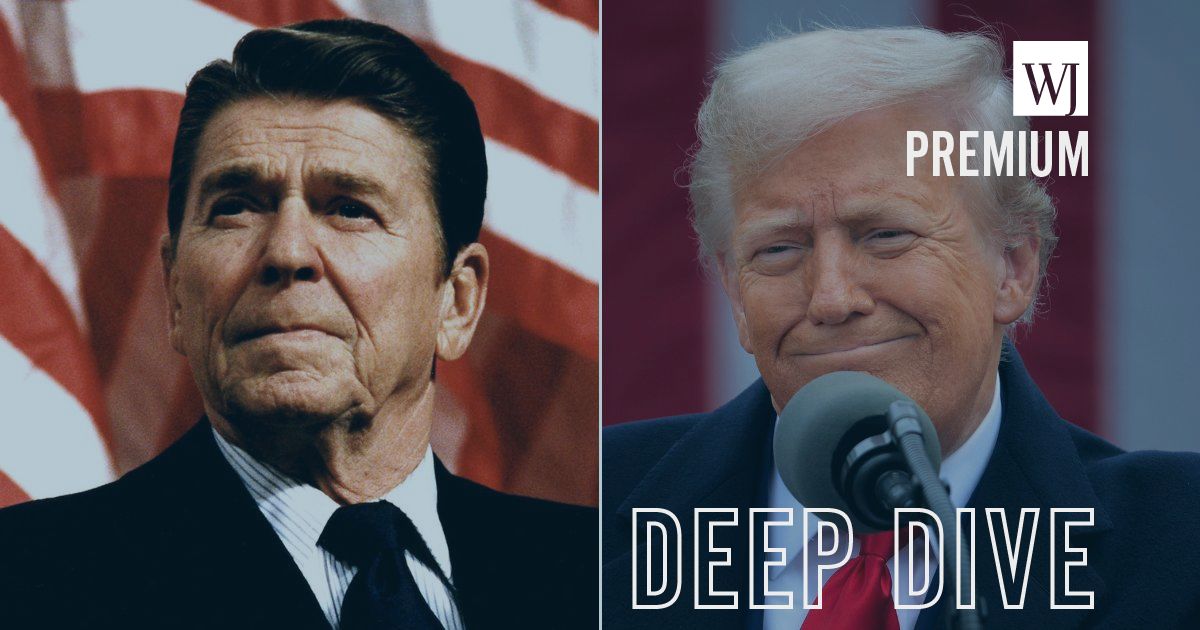


Many nostalgically look back on the 1980s, remembering it as a decade that the nation’s economy boomed under Ronald Reagan.
What people may not remember is that it didn’t start out that way. Reagan inherited a mess from Democratic President Jimmy Carter, and it took some bold moves to get the American economy out of its malaise.
President Donald Trump faces a similar situation now, and he’s taking some strong action to get the United States economy back on a sustainable path.
When Reagan assumed office in January 1981, interest rates and inflation were both at double digits, while unemployment hit nearly 11 percent shortly into his first term. It was the worst recession to that date since the Great Depression in the 1930s.
Reagan famously said in his inaugural address, “In this present crisis, government is not the solution to our problem; government is the problem. …
“It is time to reawaken this industrial giant, to get government back within its means, and to lighten our punitive tax burden. And these will be our first priorities, and on these principles there will be no compromise,” he proclaimed.
“In this present crisis, government is not the solution to our problem; government is the problem.” – Ronald Reagan, 1981. pic.twitter.com/XgcBGUCTFZ
— Ronald Reagan Presidential Foundation & Institute (@RonaldReagan) November 16, 2024
And that’s exactly what Reagan and the Congress did, starting in the summer of 1981, passing across-the-board tax cuts on individuals and businesses. And Reagan slashed regulations, including those holding back energy production in the U.S.
What was the result? Nearly 25 years of uninterrupted economic growth. All this didn’t happen overnight.
First, inflation had to be broken by raising interest rates for a time, which sent the country into a deep recession in 1982; however, by the end of that year, it had ended, and by 1983, the economy was booming.
Employers added 3.5 million new jobs in that and 3.9 million in 1984.
By January 1985, the unemployment rate had dropped from a high of 10.8 percent in December 1982 to 7.3 percent in January 1985, at the beginning of Reagan’s second term. It would fall to 5.4 percent by the time he left office in January 1989.
Further, the American economy grew by about one-third during the 1980s, which was more than the entire economic output of West Germany during this time frame.
Trump faced a different but still challenging economic situation from Reagan as the 47th president took over from Democrat Joe Biden in January.
Biden and the Democratic-led Congress placed the U.S. on an unsustainable path, building an economy based on borrowed and printed money to the tune of nearly $2 trillion in deficit spending a year.
The federal government spent a total of $4.4 trillion under Trump in 2019 during his first term, before the pandemic.
Under Biden last year, that amount had ballooned to $6.8 trillion. The Treasury only took in $4.9 trillion in fiscal year 2024, meaning a $1.8 trillion deficit. The interest payment on the national debt was $881 billion, more than the entire defense budget.
As Trump Treasury Secretary Scott Bessent told Fox News this week, “We were on our way to a financial crisis. … With that gigantic government spending, it was unsustainable.”
“If you look back in ’07 … right before, it looked great, before everything collapsed,” he said. “We have taken us off that trajectory, and we have put ourselves on a sound trajectory.”
This administration has taken the United States off the trajectory of past recessionary trends and put us back on a sound trajectory for growth. pic.twitter.com/PVocSgZRbz
— Secretary of Treasury Scott Bessent (@SecScottBessent) April 3, 2025
Bessent said part of the solution is the new tariff policy Trump announced Wednesday, which is expected to bring in hundreds of billions of dollars in revenue.
The Trump administration is also looking to cut up to $1 trillion per year in spending through its Department of Government Efficiency, as well as spur economic growth through smart tax cuts, which in the end will bring in more revenue.
This was the case during Trump’s first term and under Reagan, because more growth means more jobs and more people and businesses paying taxes. Before Trump’s tax cuts in 2017, federal revenue was $3.3 trillion. As mentioned above, with his tax cut regime still mostly in place, the Treasury took in $4.9 trillion last year.
During a cabinet meeting last month, Bessent said, “We are re-privatizing the economy, we are bringing down government spending, we are bringing down excess employment in the government sector… We are going to have all the new manufacturing jobs… We are going to get the affordability crisis fixed.”
.@SecScottBessent: “We are re-privatizing the economy, we are bringing down government spending, we are bringing down excess employment in the government sector… We are going to re-leverage the banking system. We are going to have all the new manufacturing jobs… We are going… pic.twitter.com/zhxxP6XsBR
— Rapid Response 47 (@RapidResponse47) March 24, 2025
After the stock market took a big hit on Thursday, Trump told reporters regarding his tariff policy and the economy, “It was an operation, like when a patient gets operated on. It’s a big thing. I said this [would] exactly be the way it is.” In other words, expect some turbulence.
But he pointed to the nearly $5 trillion in investment into the U.S. economy pledged since he’s taken office as proof that his plan to bring manufacturing back to the U.S. through tariffs and pro-growth tax and regulatory policies is working.
“The rest of the world wants to see is there any way to make a deal,” Trump said.
PRESIDENT TRUMP: “The markets are going to boom. The stock is going to boom. The country is going to boom — and the rest of the world wants to see is there any way they can make a deal.” pic.twitter.com/gwC3WSyzIM
— Trump War Room (@TrumpWarRoom) April 3, 2025
Trump once again finds himself on a similar path to Reagan, and hopefully, he will usher into the 2020s a boom like that seen in the 1980s.
Advertise with The Western Journal and reach millions of highly engaged readers, while supporting our work. Advertise Today.
